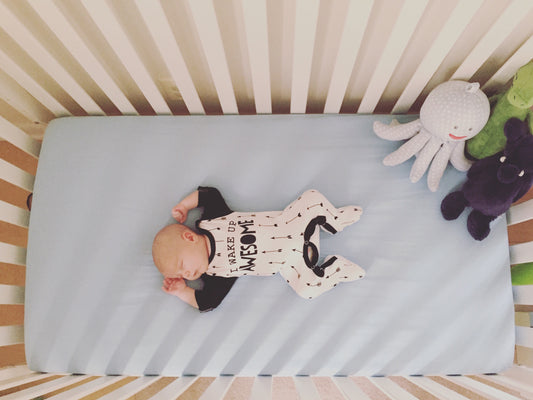What to Focus on During the First Week with a Newborn
Written by: Rachel Norman
I remember the first hour home from the hospital with our firstborn.
I sat in a chair with her on my lap and my husband and I just stared at her. We were checking out her belly button making sure everything was okay when she sneezed.
She sneezed twice in a row and my husband and I agreed it was the sweetest thing that had ever happened in the whole wide world.
There’s nothing more joyful than bringing your baby home from the hospital. It’s wonderful having a tiny little one to snuggle and love! I remember bringing my firstborn home like it was yesterday. I remember all the emotions and feelings that bubbled to the surface.
I was a mother. I had a baby. A baby I was fully responsible for. Previously this seemed like an easy enough thing, but now that my baby was home, I was stunned by this unpredictable little baby and all her needs.
The fact is taking care of a baby can seem daunting and overwhelming, but it doesn’t have to be.
The first week home is for bonding and nurturing. And one other thing - something that’ll help baby stay content for weeks and months to come - and that thing is this: giving baby full feeds.
Babies with full tummies rest better. They rest longer. They are more content and peaceful overall.
This is the goal, to have content babies who feed and rest well.

When You Come Home
When you bring baby home the hospital he’ll eat frequently. His tummy is very small, after all. If you focus on giving baby a full feed every time he is hungry, this sets baby up for a natural routine and rhythm every few hours.
1. Avoid snacking
Encourage full feeds when baby shows signs of hunger. If after a few minutes baby falls asleep, gently rouse him and continue to feed until you’re sure he’s had quite enough. This will usually take at least 20 minutes if you are nursing, but often lasts as long as 40 minutes.
2. Eat-Play-Sleep
Want your baby to go to sleep on his own? The eat-play-sleep cycle helps baby learn to sleep on their own quite easily. When you give your baby a full feed, that is the time for a few songs, cuddles, and kisses before putting baby down to sleep. If babies get used to falling asleep while nursing or drinking they’ll struggle to go to sleep on their own in a few months.
3. Understand baby’s sleep needs
You will be surprised - shocked even - at how much baby can sleep in those first few weeks. Baby will likely want to feed every 2.5 to 3 hours and can probably take a nap for at least an hour between every feed!
4. Keep babies awake for full feeds
If baby nods off during a feed, rub his feet, his hands, or his cheeks. Take this opportunity to burp baby or to change his diaper. Then continue feeding until baby has had a full feed. This makes for a happy baby.
Little babies don’t need much. They need love, attention, and to have their basic needs met. Though this season of life may seem overwhelming in some ways, it is truly a precious time. By starting some simple habits early on, you’ll increase the odds of having a peaceful and content baby.
When babies are content they eat better, sleep better, and are generally more settled.
As you are laying baby down to sleep many mothers find white noise to be helpful. Using SoundBub’s white noise machine and bluetooth speaker, you can make sure baby has soothing sounds in the background as they’re going to sleep. This is something you can start from Day One that will become a positive sleep association for baby.
The SoundBub is also compatible with WavHello’s VoiceShare app which allows you to play songs, albums, or even books to help baby relax and get used to being part of your family. By creating these mini routines within your day baby will thrive on the predictability and security it brings.
This post is part of an 8-post series:
Part 1: What To Focus On During The First Week With A Newborn (you are here)
Part 2: The Importance Of Swaddling: How And Why
Part 3: How To Create A Wind-Down Routine For Baby
Part 4: The Sleep Window: How To Recognize Baby’s Sleep Cues
Part 5: Classic Signs Of Overtiredness And How To Prevent It
Part 6: A Surefire Way To Help Baby Sleep More Soundly
Part 7: Early Morning and Dream Feeds: How To Do Them And Wean Them







